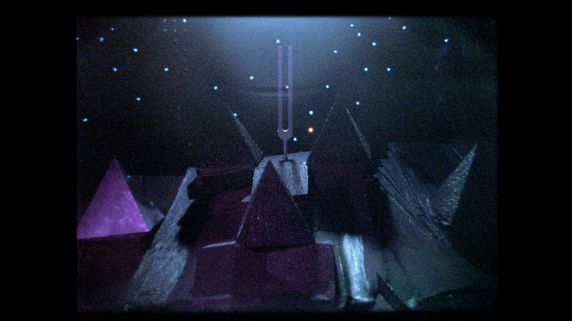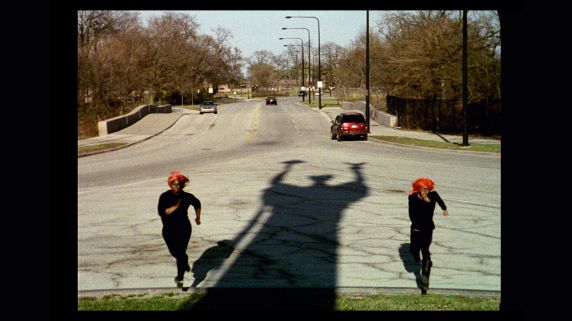
Cauleen Smith. "By The Nile," 2012. Film still from a 16mm to digital print. Cinematography, Cauleen Smith and Ian Curry. Courtesy the artist.
As part of a series of Art21 blog posts about the Afrofuturist influence in contemporary art, I interviewed American filmmaker Cauleen Smith, whose A Star Is a Seed is currently on view at the Museum of Contemporary Art Chicago. Her exploration is essentially thematic, with many cultural and historical connections. For example, Sanford Biggers’ Codex imagines Harriet Tubman, a conductor on the Underground Railroad, as an astronaut “traversing the south to the north by navigating the stars.” One hundred and sixty years earlier escaped slave Frederick Douglass included in his essay a celestial analogue as a comparison for the duration of structural inequality in the United States,
“[T]hey lived then, had lived before, and will, probably, ever have a place on this planet; and their course, in respect to any great change, (no matter how great the good to be attained, or the wrong to be redressed by it), may be calculated with as much precision as can be the course of the stars.”
Afrofuturism, as a practice, attracts contemporary artists who are fascinated with the translation of that which is spiritual or theoretical, into something visible that viewers can relate to, in particular, the representation of sound, movement, visual art, African (black) heritage and liberation. In The Black Atlantic: Modernity and Double-Consciousness, scholar Paul Gilroy includes part of his 1993 interview with Toni Morrison that explores the important relationship between music and other forms of cultural expression – i.e. “black art.” The Black Atlantic, or the effect of a historical mass-dispersion of African people with common roots, is defined by Gilroy as the desire to transcend structural inequalities and the constraints of ethnicity and nationality. The creative antiphony (formal response) of artists like Cauleen Smith helps to further explain Afrofuturism as a way to envision alternative futures and our place in the universe. I asked Cauleen to address a part of the Gilroy-Morrison discussion regarding the nature of black art.
Nettrice Gaskins: Toni Morrison describes the elements of black art: (a) the ability of artists to use found objects; (b) the appearance of using found things; and (c) the work must look effortless. She states, “It must look cool and easy. If it makes you sweat, you haven’t done the work.” How might her statement relate to your interpretations of existing work (artifacts) within African and African-diaspora culture – i.e. as it relates to improvisation?
Cauleen Smith: I guess, despite the fact that I find Toni Morrison’s work and ideas profound and important to my work and development as an artist-person, I’d love to see the original source for these ideas here, because there are some words in there that are so loaded and, to my mind, subjective, that I’m not sure I can wholly sign on to this as a way to talk about what I attempt to do. What looks like “sweat” to her could look slick and machined to me. Is slick the same as “cool”? Does the touch of the hand in a thing or a deliberately exposed flaw immediately render it overly labored and therefore not “easy” or under-labored suggesting that I haven’t “done the work?” I’m afraid that I’m ignorant of the qualifiers she uses for these terms and therefore uneasy with that track.
However, in some of my sketchbooks, I re-copy this list (below) of terms which seek to describe works and ideas that exist “in-between” what is central and what is marginal, known and unknown: hybridity, trans temporal, collage, recycle, mélange, appropriation, hotchpotch, leapfrog, the tether, the loop, synergy, hand-made, bricolage, improvisation, mongrelisation, margin, void, syncretism, transculturation–the list changes and grows depending on what I’m trying to make at the time that I transpose it. I’m just a formal-structuralist in the way that I approach image making, and I am looking at things in the world, with the aim of linking up my ideas with ideas already circulating, through space, through time, through bodies, though land. Just so happens that African-American history is the perfect material for future speculation, our collective experience is a metaphor for human life in times to come. As we put ourselves into pods and shoot ourselves into space for distances so great that we forget who we are before we even arrive at our destination we will be forced to master the disciplines archeology and speculation to rebuild our future-human selves in future human-sustainable spaces.

Cauleen Smith. "The Solar Flare Arkestral Marching Band in conjunction with the Rich South High School Marching and play Chicago Meat Market," (2012). Digital Film Still Cinematography: Mike Gibisser. Courtesy the artist.
A Star Is a Seed evolved from Smith’s explorations of Afrofuturism, by experimental musician Sun Ra—an opportunity that coincided with her 2010 residency at threewalls. The residency included a trilogy of films and videos that examine the “application of music as transformative technology within an urban matrix.” A Star Is a Seed is borrowed from Stevie Wonder’s A Star’s A Seed/Tree Medley, from the 1979 album Journey Through the Secret Life of Plants, Vol. II.
Our ancestors have since long ago
Passed their wisdom down so we could know
For here lies the key
That will help unfold the mystery
A seed’s a star
A seed’s a star’s a seed
A star’s a seed
A star’s a seed’s a star
Nettrice Gaskins: Your work currently on view at the MCA Chicago references Sun Ra and Stevie Wonder’s A Star’s A Seed/Tree Medley. How has this involvement with stars (and seeds) manifested in your current (and future) work?
Cauleen Smith: For the MCA Screen Show, A Seed is a Star, I stumbled on a tiny scientific discovery that allowed me to interweave several eccentric obsessions (Dogon technology, Sun Ra, The Secret Life of Plants album and movie, and astronomical phenomena) cosmic odysseys and origin myths on a quest for subjectivity and the fragility of interiority–our inner-space, upon which exterior gestures and markers often confine and constrict mobility. How do we first imagine and then make material, worlds that support rather than oppose self-determination, creative practices, and intellectual curiosity? I looked at the time Sun Ra spent in Chicago honing his Sun Ra persona, but I looked at the city itself as it seems to be an incubator for stalwart and radically fresh black talent, no? So that was the macro-fulcrum and then the micro-anchor was a discovery by some scientists in Florida who discovered that the reddish material that makes the curly hair-like tendrils on the seeds of the Strelitzia Nicolai and the Strelitzia Regina flowers (two strains of the S. African Bird of Paradise flower) bright orange is bilirubin, a chemical also found in humans and animals.
(I consider this a feminist afro-futurist position as opposed to more traditional and academically institutionalized “black subjectivity” which often seems to advocate for a kind of black male liberation that, visually at least, relegates women to objects and/or obstacles, and erases a black female presence altogether!)

Strelitzia reginae – Bird of Paradise. Image by Mila Zinkova - under the terms of the GNU Free Documentation License, Version 1.2.
Cauleen Smith: I must quickly assert here that the fabulous term, “cognitive estrangement,” that scholar Dark Suvin asserted back in the 1970’s helps describe the strategies deployed in science fiction rather than other genres which are often lumped in with SF-like fantasy (Harry Potter) or genre bending (Star Wars – a Western). I believe that the current ubiquitousness of the term afro-futurism (and I spell it with a lowercase “a” because I speak of it as a movement in history rather than as a moniker for a people, right?
Nettrice Gaskins: After covering Sanford’s Mass MoCA show I was discussing it with an Art21 editor and we’re seeing so much Afrofuturist influence right now – e.g. Sanford Biggers and Rashid Johnson – that draw heavily from it. I have some ideas about that, but why do you think this is?
Cauleen Smith: I guess I wonder what is meant by “afro-futurist influence?” If you mean that it is very common for African-American artists to pepper their work with technological or cosmological signifiers or use outer space as a metaphor for the collective memory of oppressive social and economic paradigms, then I’d say that’s nothing new in the least bit. For instance, Sun Ra was born in 1914. John Corbett and Jon Szwed point out that as Herman Blount, Sun Ra grew up listening to religious sermons in which the minister would take his congregation on a voyage through the “heavens” past the moon, past Venus and onwards to Jupiter. These poetic strategies have been in play with African-Americans since we adopted Christianity as a survival mechanism against and through slavery. As a people we have traveled unimaginable distances, landed on alien soils, and existed as an alternate species. This is not new, it is now simply placed into the central arena. I think I get at this in an earlier question but I would add that the ascendance of black artists as players in the art-market has simply rendered visible for the art world practices that were previously invisible to “them” (Them) because it just wasn’t in front of us, we were not seeing it–it was in the margins.

Cauleen Smith. "Nicolai and Regina Series 01 (film still)," 2012. 16mm - digital print. Cinematography: Cauleen Smith and Ian Curry. Courtesy the artist.
But to me afro-futurism as a practice, as a way of making and thinking means more than just naming a piece after the Gemini Space probe or some such. For me afro-futurism centralizes formal considerations, structural considerations, and the stakes are in the praxis as much as in the language–if not more so. One of those practices, I believe, is most definitely the mastery of improvisation. And this leads towards the century-old complaint among visual artists that we’ve failed to develop a visual language that approaches the dominance and sophistication that African-American musicians achieved with music. However, looking at fashion and hip-hop–the lifestyle, not the music, I would have to say that maybe this isn’t true. Clearly contemporary street art and both hi and low fashion are indebted to urban visual culture…and once again, improvisation, stealth, slight of hand, marginality as an offensive rather than defensive position are in play. The formal concerns are where the stakes are because of the fierce rigor required to create alternative forms, alternative structures. It’s not that hard to name a record album after Sputnik, or a planet. It is more difficult (and to me more interesting) to generate several volumes of text devoted to deconstructing language, speculating about the past as it relates to the future, and living by the very forms proposed in your work and poetry as Sun Ra did and as Harriet Tubman did. You see? And I invoke Ms. Tubman because astronomy is the first and most ancient black tech we know of right? She used this technology exactly as it should be used: as a tool for liberation.
Nettrice Gaskins: Exactly right! So what’s next or what are you working on now? What else would you like Art21 readers to know about your work, or research?
Cauleen Smith: Coming soon to New York will be the Supernova Procession! A work commissioned by Issue Projects, which combines my interest in the procession, improvisational music, and public disruptions. The Supernova Procession celebrates and combines two disparate and important events from 2011: The first was on August 25, 2011 when Berkeley scientists’ telescope detected the birth of a Supernova (an exploded star) in our very near pinwheel galaxy, M101, located in the handle of the Big Dipper. The second event was the eruption of the Occupy Wall Street Movement, which occurred according to Wikipedia on September 17, 2011. It was at this moment that the Supernova was actually peaking in brightness. The pinwheel galaxy (host to the PTF11kly supernova) is only 21 million light years away which is a very close relative to the Ia-type supernova that astronomers are accustomed to observing. Think about it, when the light from this exploded star reached our planet, we were witnessing an event that actually occurred 21 million years ago. And scientists are very keen to observe this event, because we still have so many unanswered questions about the origin of our universe, and therefore many questions about out fate in the universe. In other words, the Supernova reminds us of all we must learn from our past in order to imagine and prepare for our futures. The Procession will consist of improvised vocalizations, improvised percussion from homemade instruments, and a “football” team kicking a can down the road, all dressed as exploding stars (black soccer jerseys studded with mirrors). I hope you can come, should be fun.
More information about Cauleen’s The Association for Cinematic Creative Maladjustment: A MANIFESTO can be found online.
Cauleen Smith: A Star Is a Seed is on view at the MCA Chicago through September 16.




Pingback: Yayoi Kusama at the Whitney: Accumulation, Infinity and the Multiverse | Art21 Blog
Pingback: Yayoi Kusama at the Whitney: Accumulation, Infinity and the Multiverse | Uber Patrol - The Definitive Cool Guide
Pingback: Sanford Biggers Studio Visit in NYC « SL Art HUD Blog Thingie:
Pingback: Polyculturalist Visions Revisited | Art21 Blog
Pingback: Polyculturalist Visions Revisited | Uber Patrol - The Definitive Cool Guide
Pingback: Actors, Artifacts & Craft Pt. 2: High-Low Fashion « SL Art HUD Blog Thingie:
Pingback: Art21 2009 to the Present « SL Art HUD Blog Thingie:
Pingback: In the Shadow of the Sun (Ra) | Michael J. Kramer
Pingback: Fuzzy Phenomena: Plants, Planets & Cultural Alchemy | Renegade Futurism